| Home | Nature Weekly Index |
22 November 2015 | Field Trip | Sungei Buloh Wetland Reserve |
Last Saturday, I made my second trip this year to Sungei Buloh Wetland Reserve (SBWR). In the last trip in August, I did not make it to the entrance of SBWR due to the wet weather. This time round, I also spent most of my time at the new extension area outside of the Reserve. In contract to the previous trip, the weather was rather hot that day.
The highlight of this trip was a light orange stink bug found on the Api-api Putih tree (Avicennia alba). As I had spotted several of them including nymphs on this tree, I was quite certain that the tree should be its host plant. Actually, I saw a lone nymph in this same tree in my August trip. To my delight, not to far down the track from where I saw the adult bugs, I spotted a group of newly hatched nymphs on a leaf of the Sea Hibiscus (Talipariti tiliaceum); a total of 12 little creatures. Judging from the white line that run across the body of the otherwise all black body, I suspected that they were indeed the nymphs of the same orange bug I saw earlier. The subsequent search for its identity was not successful. The closest I could get was an Antestiopsis species (Coffee Bug). Surprisingly, there was no sign of the common Mangrove Stink Bug (Calliphara nobilis).

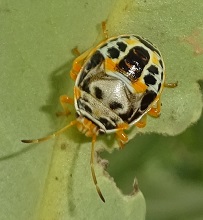
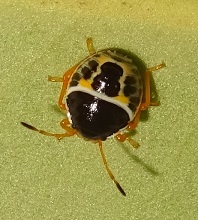
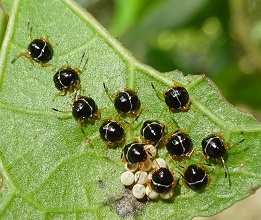
On a climber, Canavalia cathartica, there were several small all-black bugs gathering along the slender stem. From afar, they looked like ladybird beetles. At first, I thought they were a bug, Brachyplatys subaeneus that I saw previously on another climber, Mikania micrantha. But, after noticing the few tiny orange spots on their back, it should be another species of bug in the same genus, probably Brachyplatys punctipes.
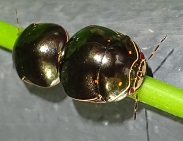
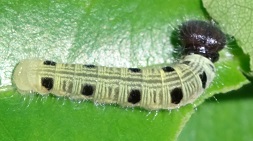
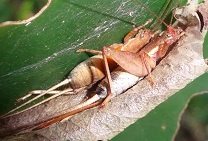 Another rare sighting was the caterpillar of the skipper,
White Banded Awl (Hasora taminatus malayana).
According to the information from the Butterfly Circle website,
this skipper is relatively rare. Also, it is typically difficult to find
skipper caterpillar exposed in bright daylight. Sure enough, it only appeared for a few minutes and soon disappeared into its hideout
made from the leaf of the climber Common Derris (Derris trifoliata).
Another rare sighting was the caterpillar of the skipper,
White Banded Awl (Hasora taminatus malayana).
According to the information from the Butterfly Circle website,
this skipper is relatively rare. Also, it is typically difficult to find
skipper caterpillar exposed in bright daylight. Sure enough, it only appeared for a few minutes and soon disappeared into its hideout
made from the leaf of the climber Common Derris (Derris trifoliata).
The sighting of a pair of co-habit crickets (Ornebius rufonigrus) in a dried leaf helped me to clarify the identity of the relationship between a light brown cricket and one with an orange mid-body region --- one is a female while another is a male.
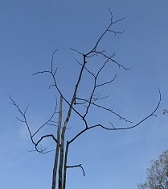
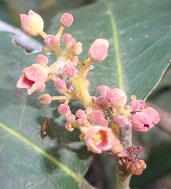 On the plant side, I was so happy to finally get the pictures of the flowers from the
Dungun tree (Heritiera littoralis). The first time I saw this tree was
6 years back but I never had a chance to see its flowers in the field until this day. When I came across the first flowering tree,
the flower stalks were too high to take any decent pictures. My luck was pretty good that day. While walking along the trail heading
back the main road, I was elated to find a large tree that were flowering with the flowers just at my eye level.
On the plant side, I was so happy to finally get the pictures of the flowers from the
Dungun tree (Heritiera littoralis). The first time I saw this tree was
6 years back but I never had a chance to see its flowers in the field until this day. When I came across the first flowering tree,
the flower stalks were too high to take any decent pictures. My luck was pretty good that day. While walking along the trail heading
back the main road, I was elated to find a large tree that were flowering with the flowers just at my eye level.
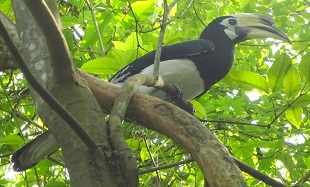 As for the lone flowering Velvet Tamarind (Dialium indum) treelet seen in the
last trip, all the leaves were gone with just empty branches. I was not sure whether it was still alive. Nevertheless, I happened to
find another treelet near the pond area.
As for the lone flowering Velvet Tamarind (Dialium indum) treelet seen in the
last trip, all the leaves were gone with just empty branches. I was not sure whether it was still alive. Nevertheless, I happened to
find another treelet near the pond area.
Last but not least, I finally managed to take some pictures of the Oriental Pied Hornbill (Anthracoceros albirostris) on the trees near the entrance of the Reserve. I had seen these hornbills at least in 2 previous occasions but had never had a chance to snap any of their pictures.